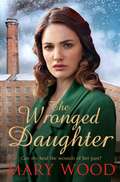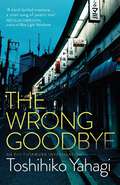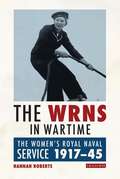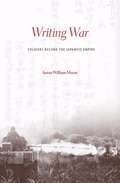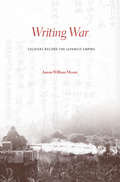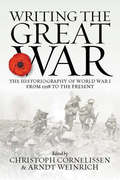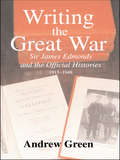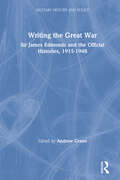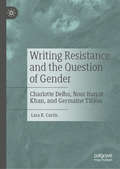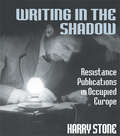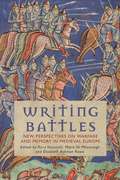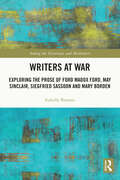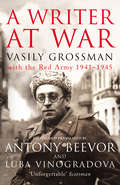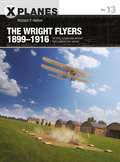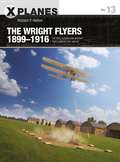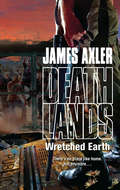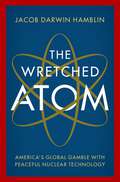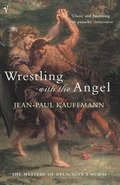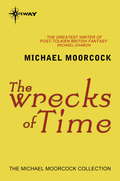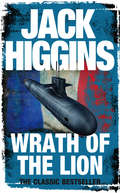- Table View
- List View
The Wronged Daughter: A Heart-Warming Wartime Saga Perfect For Winter Nights (The Girls Who Went To War)
by Mary WoodPerfect for winter nights, The Wronged Daughter by Mary Wood is an emotional and moving novel that reunites old friends and heals old wounds. Mags has never forgotten the friendship she forged with Flora and Ella, two fellow nurses she served with at the beginning of World War I. Haunted by what she experienced during that time, she fears a reunion with her friends would bring back the horror she’s tried so desperately to suppress. Now, with her wedding on the horizon, this should be a joyful time for Mags. But the sudden loss of her mother and the constant doubt she harbours surrounding her fiancé, Harold, are marring her happiness. Mags throws herself into running the family mill, but she’s dealt another aching blow by a betrayal that leaves her reeling. Finding the strength the war had taken from her, she fights back, not realizing the consequences and devastating outcome awaiting her. Can she pick up the pieces of her life and begin anew?
The Wrong Goodbye
by Toshihiko YahagiA classic slice of Japanese hard-boiled noir paying homage to the master of the genre: Raymond ChandlerThe Wrong Goodbye pits homicide detective Eiji Futamura against a shady Chinese business empire and U.S. military intelligence in the docklands of recession Japan. After the frozen corpse of immigrant barman Tran Binh Long washes up in midsummer near Yokosuka U.S. Navy Base, Futamura meets a strange customer from Tran's bar. Vietnam vet pilot Billy Lou Bonney talks Futamura into hauling three suitcases of "goods" to Yokota US Air Base late at night and flies off leaving a dead woman behind. Thereby implicated in a murder suspect's escape and relieved from active duty, Futamura takes on hack work for the beautiful concert violinist Aileen Hsu, a "boat people" orphan whose Japanese adoption mother has mysteriously gone missing. And now a phone call from a bestselling yakuza author, a one-time black marketeer in Saigon, hints at inside information on "former Vietcong mole" Tran and his "old sidekick" Billy Lou, both of whom crossed a triad tycoon who is buying up huge tracts of Mekong Delta marshland for a massive development scheme. As the loose strands flashback to Vietnam, the string of official lies and mysterious allegiances build into a dark picture of the U.S.-Japan postwar alliance. Translated from the Japanese by Alfred Birnbaum
The WRNS in Wartime: The Women's Royal Naval Service 1917-1945 (International Library of War Studies)
by Hannah RobertsThe Women's Royal Naval Service (WRNS) was created in 1917, re-formed in 1938 and maintained after 1945. This book determines for the first time the reasons for the expansion and contraction of the service and the impact key individuals had on it and in turn the influence it had on its members. Hannah Roberts offers new insights into a previously little studied British military institution, which celebrates its centenary in 2017. She shows how political and military decision-making within the fluctuating national security situation, coupled with a growing cultural acceptability of women taking on military roles, allowed for the growth of the service in World War II into realms never expected of women. Although it shared a similar pattern in its formation to the Auxiliary Territorial Service (ATS) and had a similar ethos to its Air Force counterpart, the WAAF, the WRNS took on a wider-ranging role in the war, in part due to the latitude afforded to the service because of its uniquely independent origins. From 1941 onward the WRNS spread internationally and subverted the combat taboo by adopting semi-combatant roles. Using twenty-one new oral histories and a multitude of archived personal documents, this book demonstrates the pivotal importance of the Women's Royal Naval Service in both the world wars.
Writing War: Soldiers Record The Japanese Empire
by Aaron William MooreWriting War examines over two hundred diaries, and many more letters, postcards, and memoirs, written by Chinese, Japanese, and American servicemen in the Pacific from 1937 to 1945. As he describes conflicts that have often been overlooked by historians, Aaron William Moore reflects on diaries as tools in the construction of modern identity.
Writing War: Soldiers Record The Japanese Empire
by Aaron William MooreWriting War examines over two hundred diaries, and many more letters, postcards, and memoirs, written by Chinese, Japanese, and American servicemen in the Pacific from 1937 to 1945. As he describes conflicts that have often been overlooked by historians, Aaron William Moore reflects on diaries as tools in the construction of modern identity.
Writing the Great War: The Historiography of World War I from 1918 to the Present
by Christoph Cornelissen and Arndt WeinrichFrom the Treaty of Versailles to the 2018 centenary and beyond, the history of the First World War has been continually written and rewritten, studied and contested, producing a rich historiography shaped by the social and cultural circumstances of its creation. Writing the Great War provides a groundbreaking survey of this vast body of work, assembling contributions on a variety of national and regional historiographies from some of the most prominent scholars in the field. By analyzing perceptions of the war in contexts ranging from Nazi Germany to India’s struggle for independence, this is an illuminating collective study of the complex interplay of memory and history.
Writing the Great War: The Historiography of World War I from 1918 to the Present
by Christoph Cornelissen Arndt WeinrichFrom the Treaty of Versailles to the 2018 centenary and beyond, the history of the First World War has been continually written and rewritten, studied and contested, producing a rich historiography shaped by the social and cultural circumstances of its creation. Writing the Great War provides a groundbreaking survey of this vast body of work, assembling contributions on a variety of national and regional historiographies from some of the most prominent scholars in the field. By analyzing perceptions of the war in contexts ranging from Nazi Germany to India’s struggle for independence, this is an illuminating collective study of the complex interplay of memory and history.
Writing the Great War: Sir James Edmonds and the Official Histories, 1915-1948
by Andrew GreenBegun within months of the war's outbreak, and not completed for a further 33 years, the writing of the Official Histories of World War I was a venture of unprecedented scale and complexity.Who, then, was responsible for producing such an enterprise? Did it aim to inform or did it have darker political motivations? Did the authors, who alone had ac
Writing the Great War: Sir James Edmonds and the Official Histories, 1915-1948 (Military History And Policy Ser. #No. 11)
by Andrew GreenBegun within months of the war's outbreak, and not completed for a further 33 years, the writing of the Official Histories of World War I was a venture of unprecedented scale and complexity.Who, then, was responsible for producing such an enterprise? Did it aim to inform or did it have darker political motivations? Did the authors, who alone had ac
Writing Resistance and the Question of Gender: Charlotte Delbo, Noor Inayat Khan, and Germaine Tillion
by Lara R. CurtisThis book presents the first comparative study of the works of Charlotte Delbo, Noor Inayat Khan, and Germaine Tillion in relation to their vigorous struggles against Nazi aggression during World War II and the Holocaust. It illuminates ways in which their early lives conditioned both their political engagements during wartime and their extraordinary literary creations empowered by what Lara R. Curtis refers to as modes of ‘writing resistance.’ With skillful recourse to a remarkable variety of genres, they offer compelling autobiographical reflections, vivid chronicles of wartime atrocities, eyewitness accounts of victims, and acute perspectives on the political implications of major events. Their sensitive reflections of gendered subjectivity authenticate the myriad voices and visions they capture. In sum, this book highlights the lives and works of three courageous women who were ceaselessly committed to a noble cause during the Holocaust and World War II.
Writing in the Shadow: Resistance Publications in Occupied Europe
by Harry StoneThe first complete national and international survey in the English language of the clandestine newspapers and books published in the occupied countries of Europe during the Second World War.A man with earphones crouching in the attic listening in with a crystal set, a prisoner writing fearfully even in the condemned cell, youths taking courses in weightlifting so as to be able to carry cases of lead type with apparent ease: these are just some of the people who helped produce clandestine newspapers and books in the occupied countries of Europe during the Second World War. Writing in the Shadow describes the risks these people ran and the ingenuity and brilliant improvisation they used to hoodwink the Nazis and distribute newsletters to tens of thousands of people.
Writing in the Shadow: Resistance Publications in Occupied Europe
by Harry StoneThe first complete national and international survey in the English language of the clandestine newspapers and books published in the occupied countries of Europe during the Second World War.A man with earphones crouching in the attic listening in with a crystal set, a prisoner writing fearfully even in the condemned cell, youths taking courses in weightlifting so as to be able to carry cases of lead type with apparent ease: these are just some of the people who helped produce clandestine newspapers and books in the occupied countries of Europe during the Second World War. Writing in the Shadow describes the risks these people ran and the ingenuity and brilliant improvisation they used to hoodwink the Nazis and distribute newsletters to tens of thousands of people.
Writing Battles: New Perspectives on Warfare and Memory in Medieval Europe
by Rory Naismith Máire Ní Mhaonaigh Elizabeth Ashman RoweBattles have long featured prominently in historical consciousness, as moments when the balance of power was seen to have tipped, or when aspects of collective identity were shaped. But how have perspectives on warfare changed? How similar are present day ideologies of warfare to those of the medieval period?Looking back over a thousand years of British, Irish and Scandinavian battles, this significant collection of essays examines how different times and cultures have reacted to war, considering the changing roles of religion and technology in the experience and memorialisation of conflict. While fighting and killing have been deplored, glorified and everything in between across the ages, Writing Battles reminds us of the visceral impact left on those who come after.
Writing Battles: New Perspectives on Warfare and Memory in Medieval Europe
Battles have long featured prominently in historical consciousness, as moments when the balance of power was seen to have tipped, or when aspects of collective identity were shaped. But how have perspectives on warfare changed? How similar are present day ideologies of warfare to those of the medieval period?Looking back over a thousand years of British, Irish and Scandinavian battles, this significant collection of essays examines how different times and cultures have reacted to war, considering the changing roles of religion and technology in the experience and memorialisation of conflict. While fighting and killing have been deplored, glorified and everything in between across the ages, Writing Battles reminds us of the visceral impact left on those who come after.
Writers at War: Exploring the Prose of Ford Madox Ford, May Sinclair, Siegfried Sassoon and Mary Borden (Among the Victorians and Modernists)
by Isabelle BrasmeWriters at War addresses the most immediate representations of the First World War in the prose of Ford Madox Ford, May Sinclair, Siegfried Sassoon and Mary Borden; it interrogates the various ways in which these writers contended with conveying their war experience from the temporal and spatial proximity of the warzone and investigates the multifarious impact of the war on the (re)development of their aesthetics. It also interrogates to what extent these texts aligned with or challenged existing social, cultural, philosophical, and aesthetic norms. While this book is concerned with literary technique, the rich scholarship on questions of gender, trauma, and cultural studies on WWI literature serves as a foundation. This book does not oppose these perspectives but offers a complementary approach based on close critical reading. The distinctiveness of this study stems from its focus on the question of representation and form and on the specific role of the war in the four authors’ literary careers. This is the first scholarly work concerned exclusively with theorising writing produced from the immediacy of the war. This book is intended for academics, researchers, PhD candidates, postgraduates and anyone interested in war literature.
Writers at War: Exploring the Prose of Ford Madox Ford, May Sinclair, Siegfried Sassoon and Mary Borden (Among the Victorians and Modernists)
by Isabelle BrasmeWriters at War addresses the most immediate representations of the First World War in the prose of Ford Madox Ford, May Sinclair, Siegfried Sassoon and Mary Borden; it interrogates the various ways in which these writers contended with conveying their war experience from the temporal and spatial proximity of the warzone and investigates the multifarious impact of the war on the (re)development of their aesthetics. It also interrogates to what extent these texts aligned with or challenged existing social, cultural, philosophical, and aesthetic norms. While this book is concerned with literary technique, the rich scholarship on questions of gender, trauma, and cultural studies on WWI literature serves as a foundation. This book does not oppose these perspectives but offers a complementary approach based on close critical reading. The distinctiveness of this study stems from its focus on the question of representation and form and on the specific role of the war in the four authors’ literary careers. This is the first scholarly work concerned exclusively with theorising writing produced from the immediacy of the war. This book is intended for academics, researchers, PhD candidates, postgraduates and anyone interested in war literature.
A Writer At War: Vasily Grossman with the Red Army 1941-1945
by Vasily Grossman Antony Beevor Luba VinogradovaIn the summer of 1941 as the Germans invade Russia, Soviet Army’s newspaper reporter Vasily Grossman is swept up into the frontlines of war and witnesses some of the most savage atrocities in Russian history.As Grossman follows the Red Army from the defense of Moscow, to the carnage at Stalingrad, to the Nazi genocide in Treblinka, his writings paint a vividly raw and devastating account of Operation Barbarossa during World War Two. Grossman’s notebooks, war diaries, personal correspondence and newspaper articles are meticulously woven into a gripping narrative and provide a piercing look into the life of the author behind Life and Fate - dubbed the twentieth century War and Peace. A Writer at War stands as an unforgettable eyewitness account of the Eastern Front and places Grossman as the leading Soviet voice of ‘the ruthless truth of war’.‘A remarkable addition to the literature of 1941-45...a wonderful portrait of the wartime experience of Russia... A worthy memorial to a remarkable man’ Sunday Telegraph
The Wright Flyers 1899–1916: The kites, gliders, and aircraft that launched the “Air Age” (X-Planes)
by Richard P. HallionOrville and Wilbur Wright, two bicycle-making brothers from Dayton, Ohio, secured their place as the most famous names in aviation history when, on December 17, 1903, they made the first powered, controlled, and sustained heavier-than-air flight. But their success over the cold and windswept Carolina dunes that day has overshadowed their many other accomplishments before and after that historic flight. The Wrights' progression from theory to analysis to ground-testing components and wing shapes, and then to flight-testing kites, gliders, and their first powered aeroplane, marked the world's first successful 'X-Plane' research and development programme. They established a template all subsequent aircraft have followed, one still relevant in the era of hypersonic flight and drone research.This book traces the Wright Brothers' story, from their first success on that cold December day throughout their glory years to their eventual eclipse by other aviators. It explores in detail the process that lead them to their pioneering craft and their many subsequent achievements over the following years, and highlights their enduring importance in the age of modern flight.
The Wright Flyers 1899–1916: The kites, gliders, and aircraft that launched the “Air Age” (X-Planes #13)
by Richard P. HallionOrville and Wilbur Wright, two bicycle-making brothers from Dayton, Ohio, secured their place as the most famous names in aviation history when, on December 17, 1903, they made the first powered, controlled, and sustained heavier-than-air flight. But their success over the cold and windswept Carolina dunes that day has overshadowed their many other accomplishments before and after that historic flight. The Wrights' progression from theory to analysis to ground-testing components and wing shapes, and then to flight-testing kites, gliders, and their first powered aeroplane, marked the world's first successful 'X-Plane' research and development programme. They established a template all subsequent aircraft have followed, one still relevant in the era of hypersonic flight and drone research.This book traces the Wright Brothers' story, from their first success on that cold December day throughout their glory years to their eventual eclipse by other aviators. It explores in detail the process that lead them to their pioneering craft and their many subsequent achievements over the following years, and highlights their enduring importance in the age of modern flight.
Wretched Earth
by James AxlerAfter the Mega cull, the weak died off, so that a century later, the living have descended from only the toughest stock. Still, it takes more than strength to survive Deathlands.
The Wretched Atom: America's Global Gamble with Peaceful Nuclear Technology
by Jacob Darwin HamblinA groundbreaking narrative of how the United States offered the promise of nuclear technology to the developing world and its gamble that other nations would use it for peaceful purposes. After the Second World War, the United States offered a new kind of atom that differed from the bombs that destroyed Hiroshima and Nagasaki. This atom would cure diseases, produce new foods, make deserts bloom, and provide abundant energy for all. It was an atom destined for the formerly colonized, recently occupied, and mostly non-white parts of the world that were dubbed the "wretched of the earth" by Frantz Fanon. The "peaceful atom" had so much propaganda potential that President Dwight Eisenhower used it to distract the world from his plan to test even bigger thermonuclear weapons. His scientists said the peaceful atom would quicken the pulse of nature, speeding nations along the path of economic development and helping them to escape the clutches of disease, famine, and energy shortfalls. That promise became one of the most misunderstood political weapons of the twentieth century. It was adopted by every subsequent US president to exert leverage over other nations' weapons programs, to corner world markets of uranium and thorium, and to secure petroleum supplies. Other countries embraced it, building reactors and training experts. Atomic promises were embedded in Japan's postwar recovery, Ghana's pan-Africanism, Israel's quest for survival, Pakistan's brinksmanship with India, and Iran's pursuit of nuclear independence. As The Wretched Atom shows, promoting civilian atomic energy was an immense gamble, and it was never truly peaceful. American promises ended up exporting violence and peace in equal measure. While the United States promised peace and plenty, it planted the seeds of dependency and set in motion the creation of today's expanded nuclear club.
The Wretched Atom: America's Global Gamble with Peaceful Nuclear Technology
by Jacob Darwin HamblinA groundbreaking narrative of how the United States offered the promise of nuclear technology to the developing world and its gamble that other nations would use it for peaceful purposes. After the Second World War, the United States offered a new kind of atom that differed from the bombs that destroyed Hiroshima and Nagasaki. This atom would cure diseases, produce new foods, make deserts bloom, and provide abundant energy for all. It was an atom destined for the formerly colonized, recently occupied, and mostly non-white parts of the world that were dubbed the "wretched of the earth" by Frantz Fanon. The "peaceful atom" had so much propaganda potential that President Dwight Eisenhower used it to distract the world from his plan to test even bigger thermonuclear weapons. His scientists said the peaceful atom would quicken the pulse of nature, speeding nations along the path of economic development and helping them to escape the clutches of disease, famine, and energy shortfalls. That promise became one of the most misunderstood political weapons of the twentieth century. It was adopted by every subsequent US president to exert leverage over other nations' weapons programs, to corner world markets of uranium and thorium, and to secure petroleum supplies. Other countries embraced it, building reactors and training experts. Atomic promises were embedded in Japan's postwar recovery, Ghana's pan-Africanism, Israel's quest for survival, Pakistan's brinksmanship with India, and Iran's pursuit of nuclear independence. As The Wretched Atom shows, promoting civilian atomic energy was an immense gamble, and it was never truly peaceful. American promises ended up exporting violence and peace in equal measure. While the United States promised peace and plenty, it planted the seeds of dependency and set in motion the creation of today's expanded nuclear club.
Wrestling With The Angel: The Mystery Of Delacroix's Mural
by Jean-Paul KauffmannNear the end of his life, the great Romantic artist Eug-ne Delacroix (1798-1863) painted one of the most enigmatic episodes from the Bible: Jacob wrestling with the angel. This painting, which decorates the wall of the Chapel of the Holy Angels in the Paris church of Saint-Sulpice, is Delacroix's "spiritual testament". But Sain-Sulpice is a mysterious church where everything happens behind the scenes. A fan of Inspector Maigret, Jean-Paul Kauffmann investigates the painting and the church, paying particular attention to its hidden history. He searches for clues in a bar in Dieppe, a castle in Quercy, a village in the Argonne, an oak tree in the forest at S-nart, even a golf course in the Loiret. The trail leads him to an art critic, a lecturer at the Louvre, and a sculptor who has a studio in the attic of Saint-Sulpice itself. All these intertwining threads finally come together in a central motif in which Kauffmann himself is involved. There comes a time in which everyone must wrestle with the angel.
The Wrecks of Time
by Michael MoorcockEarth zero to Earth fifteen - which was the real one?What the inhabitants of Greater America didn't realize was that theirs was the only inhabited landmass, apart from one island in the Philippines. They still talked about foreign countries, though they would forget little by little, but the countries were only in their imaginations, mysterious and romantic places where nobody actually went..That was the way it was on E-3, one of the fifteen alternate Earths that had been discovered through the subspace experiments.Professor Faustaff knew that these alternate earths were somehow recent creations, and that they were under attack from the strange eroding raids of the mysterious bands known as the D-Squads. But there were tens of millions of people on those Earths who were entitled to life and protection-and unless Faustaff and his men could crack the mystery of these worlds' creation and the more urgent problem of their impending destruction, it would mean not only the end of these parallel planets, but just possibly the blanking out of all civilization in the universe.
